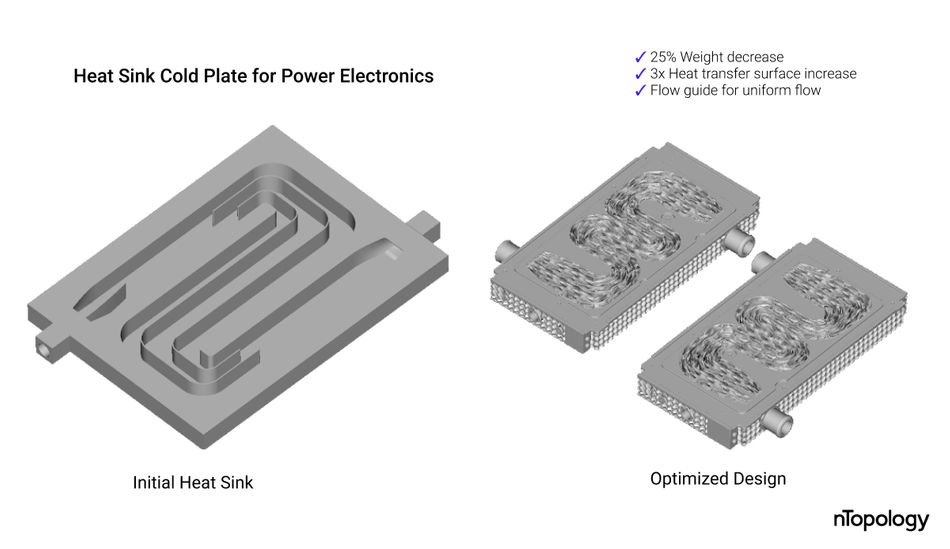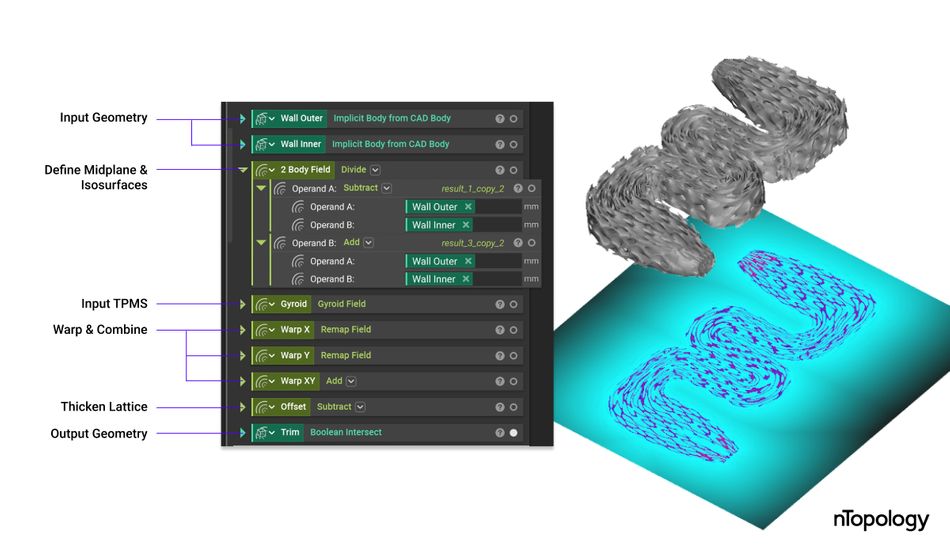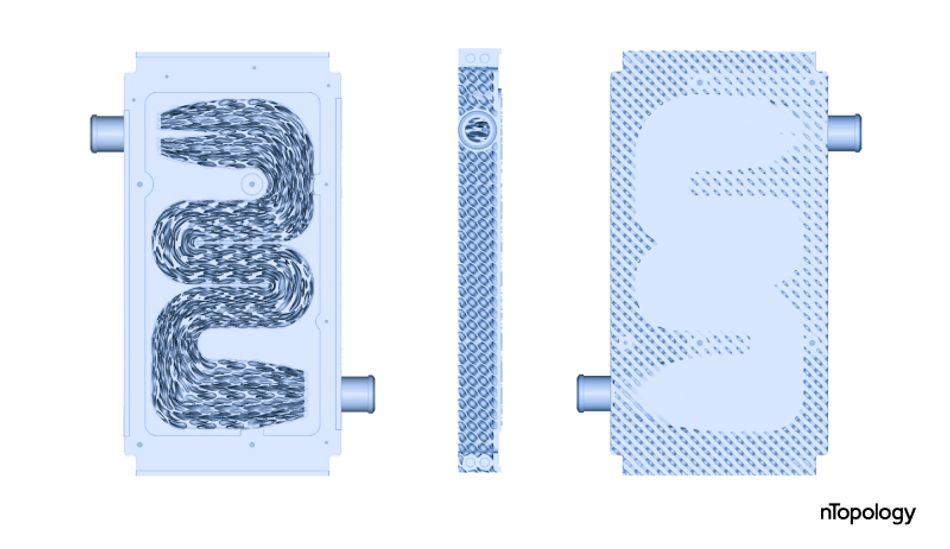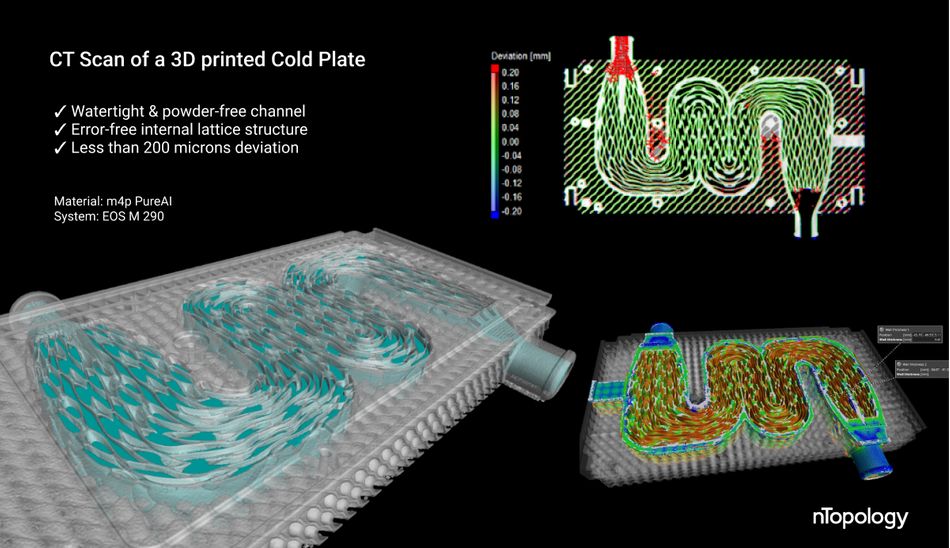Liquid-Cooled Cold Plate for Automotive Power Electronics with Shark-Inspired Flow Guides
Puntozero redesigned the cold plate of the power electronics of Dynamis PRC’s electric race car for additive manufacturing. The result was a 25% lighter liquid-cooled heat sink and bioinspired flow guides that increased the heat transfer surface area by 300%.

This article was first published on
ntopology.comBackground
The Formula SAE Electric competition is a testing ground for future mechanical, automotive and electrical engineers. Teams from universities worldwide design, manufacture, and compete with small, formula-style vehicles in a series of racing events. The electric category focuses on drivetrain innovation and fuel efficiency in a high-performance setting.
Dynamis PRC is the Formula Student team of Politecnico di Milano. Dynamis has won numerous awards and even managed to rank among the top 3 European teams in the 2019 season. In 2021, the team competed in the electric vehicle category for the first time with a brand new race car.

A key system of every electric vehicle is the power electronics that drive the electric motors. Dynamis partnered with Puntozero — an innovative product development agency specializing in design for additive manufacturing — to develop a lightweight and more efficient cooling system for their high-voltage traction inverter. The heat exchanger prototype was then additively manufactured in commercially pure aluminum by M4P.
“Multi-objective optimization when there are no fixed and tested engineering workflows is challenging. The power and flexibility of nTopology enabled us to manage the complexity of the DfAM process and grasp the concrete advantages of additive manufacturing.”Francesco Leonardi, Co-Founder at Puntozero
The Design Challenge
The high-voltage traction inverter is a power conversion unit that takes the DC power from the battery and converts it into AC to drive the motors of the electric vehicle. The traction inverter controls the torque of the motors, so it is essential to the vehicle’s performance on the road — and the race track.
The IGBT controllers of the inverter need to be kept within their optimal operating temperature range. However, the conventional liquid-cooling systems of traction inverters are typically heavy and bulky, making them non-ideal for high-performance racing applications.
The project’s goal was to design a high-efficiency cool plate that is lighter and more compact than the conventional component. The team developed a high-performance heat exchanger by taking advantage of additive manufacturing technologies and advanced engineering software.
Overview of the Solution
The engineers of Puntozero and Dynamis identified the non-uniform flow near the curvatures of the duct and the insufficient heat transfer surface area of the original CNC-machined heat sink as the main opportunities for optimization.
After multiple rapid design iteration cycles, the final cold plate heat sink features:
- Bio-inspired flow guides that result in uniform flow speed around the corners and maximize heat transfer surface.
- An external lattice structure that minimizes weight ensures manufacturability and promotes cooling by convection.
- A modular design that enables simpler service and better positioning of the cold plates.

Gyroid Structures to Guide the Flow
Inspired by the structure of shark scales, the engineers of Puntozero generated a directional lamellar geometry in nTopology that conforms to the duct of the cold plate and stirs the flow around the channel corners.

The flow guides are based on a gyroid lattice that was warped using advanced Field-Driven Design techniques.
Fields are rules that associate a numeric value to each point in 3D space. You can create fields from points, surfaces, solid bodies, or even simulation results and experimental data. In nTopology, all geometry is defined as a distance field. Using fields to drive geometry enables you to define spatial variations of complex design features in ways that would otherwise be impractical or impossible.
In this example, the engineers of Puntozero used basic math equations to create a two-body field that describes the midplane and isosurfaces of the duct’s channel. Then, they warped a gyroid lattice along the X and Y directions to guide the flow around the bends. Finally, they thickened the structure and united it with the external cell.
The result was flow guides that increase the heat transfer surface by 300% and eliminate turbulent flow along the curves.
“Thanks to nTopology, we were able to generate the lattice infill automatically. After we validated the geometry of the flow guides, we packaged the latticing workflow within a custom block, making it reusable on any future geometry.”Francesco Leonardi, Co-Founder at Puntozero
External Lattice for Lightweighting
For the main structure of the heatsink, the engineers of Puntozero selected a diamond TPMS lattice structure.
The external lattice reduced the weight and production cost of the component, improved its manufacturability, and increased the contact surface area with the power electronics to promote heat transfer.

The team took into consideration multiple engineering and manufacturing requirements while optimizing the design of the external lattice.
For example, the thickness of the lattice progressively decreases away from the contact surface with the power electronics. The thicker areas promote heat transfer, increase the efficiency of the heatsink, and provide a solid surface that can be easily supported during 3D printing. On the other hand, the thinner struts make powder evacuation easier during post-processing and promote heat dissipation by convection with the surrounding air.
The external diamond TPMS lattice significantly reduced the overall weight of the system by 25% while providing the necessary stiffness.
Manufacturing & CT Scanning
The heat sink was manufactured on an EOS M 290 system in m4p PureAl — a powder alloy optimized for additive manufacturing with a consistency close to pure aluminum. The parts were then de-powered, and CNC machined before further testing.
You always have to consider the strong influence of design, material, and process. None of these disciplines stands alone in additive manufacturing. In this project, we managed to identify the correct component orientation to enable error-free 3D printing.Bastian Kallenbach, Development Engineer at M4P

Before testing on the vehicle, the team scanned the heat sink using computational tomography. The results of the CT scan verified that 1) the channel of the heat sink was free from powder, 2) the internal lattice was manufactured without any failures, 3) the internal porosity of the part was minimal, and 4) the maximum deviation was kept to less than 200 microns throughout the volume.

The Next Steps
Dynamis PRC and Puntozero have already started working on further refining the design for next season. They are now focusing on fine-tuning the internal lattice to reduce pressure drop and minimize the overall size of the component while keeping the same heat transfer efficiency to further reduce the weight and size of the system.
nTopology’s advanced lattice generation capabilities and reusable workflows enable the team to build upon their current R&D work and create innovative solutions faster.
This case study was first published on the nTopology blog.